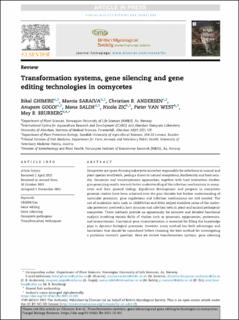| dc.contributor.author | Ghimire, Bikal | |
| dc.contributor.author | Saraiva, Marcia | |
| dc.contributor.author | Andersen, Christian B. | |
| dc.contributor.author | Gogoi, Anupam | |
| dc.contributor.author | Saleh, Mona | |
| dc.contributor.author | Zic, Nicola | |
| dc.contributor.author | van West, Pieter | |
| dc.contributor.author | Brurberg, May Bente | |
| dc.date.accessioned | 2022-02-17T14:26:37Z | |
| dc.date.available | 2022-02-17T14:26:37Z | |
| dc.date.created | 2021-12-30T18:56:47Z | |
| dc.date.issued | 2021-12-09 | |
| dc.identifier.citation | Fungal Biology Reviews. 2021, . | en_US |
| dc.identifier.issn | 1749-4613 | |
| dc.identifier.uri | https://hdl.handle.net/11250/2979785 | |
| dc.description.abstract | Oomycetes are spore-forming eukaryotic microbes responsible for infections in animal and plant species worldwide, posing a threat to natural ecosystems, biodiversity and food security. Genomics and transcriptomics approaches, together with host interaction studies, give promising results towards better understanding of the infection mechanisms in oomycetes and their general biology. Significant development and progress in oomycetes genomic studies have been achieved over the past decades but further understanding of molecular processes, gene regulations and infection mechanisms are still needed. The use of molecular tools such as CRISPR/Cas and RNAi helped elucidate some of the molecular processes involved in host invasion and infection both in plant and animal pathogenic oomycetes. These methods provide an opportunity for accurate and detailed functional analysis involving various fields of studies such as genomics, epigenomics, proteomics, and interactomics. Functional gene characterisation is essential for filling the knowledge gaps in dynamic biological processes. However, every method has both advantages and limitations that should be considered before choosing the best method for investigating a particular research question. Here we review transformation systems, gene silencing and gene editing techniques in oomycetes, how they function, in which species and what are their main advantages and disadvantages. | en_US |
| dc.language.iso | eng | en_US |
| dc.publisher | Elsevier Ltd on behalf of British Mycological Society | en_US |
| dc.rights | Attribution-NonCommercial-NoDerivatives 4.0 Internasjonal | * |
| dc.rights.uri | http://creativecommons.org/licenses/by-nc-nd/4.0/deed.no | * |
| dc.title | Transformation systems, gene silencing and gene editing technologies in oomycetes | en_US |
| dc.type | Peer reviewed | en_US |
| dc.type | Journal article | en_US |
| dc.description.version | publishedVersion | en_US |
| dc.rights.holder | © 2021 The Author(s) | en_US |
| dc.source.pagenumber | 16 | en_US |
| dc.source.journal | Fungal Biology Reviews | en_US |
| dc.identifier.doi | 10.1016/j.fbr.2021.11.001 | |
| dc.identifier.cristin | 1973057 | |
| dc.relation.project | EC/H2020/766048 | en_US |
| dc.relation.project | Andre: Newton Fund GRP Aquaculture BB/N005058/1 | en_US |
| dc.relation.project | Andre: BBSRC BB/P020224/1, BB/M026566/1 | en_US |
| cristin.ispublished | true | |
| cristin.fulltext | original | |
| cristin.qualitycode | 1 | |

